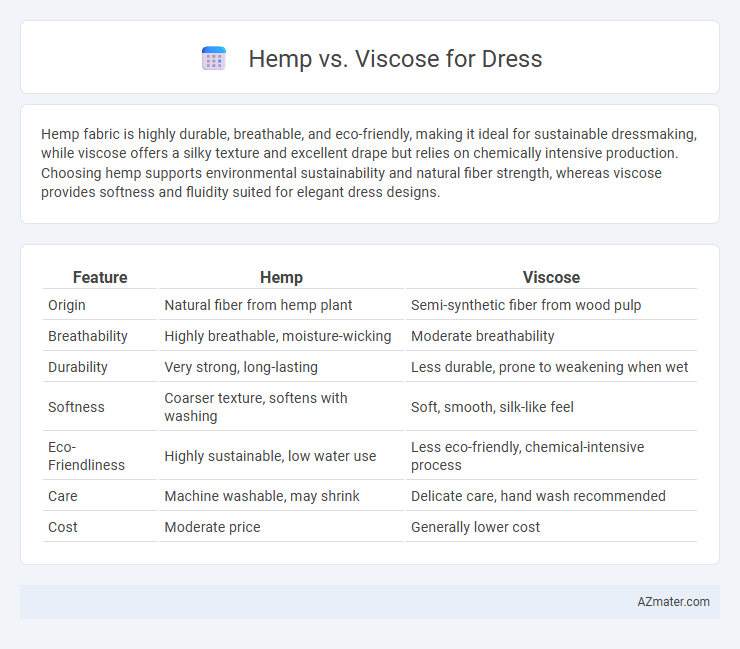Hemp fabric is highly durable, breathable, and eco-friendly, making it ideal for sustainable dressmaking, while viscose offers a silky texture and excellent drape but relies on chemically intensive production. Choosing hemp supports environmental sustainability and natural fiber strength, whereas viscose provides softness and fluidity suited for elegant dress designs.
Table of Comparison
| Feature | Hemp | Viscose |
|---|---|---|
| Origin | Natural fiber from hemp plant | Semi-synthetic fiber from wood pulp |
| Breathability | Highly breathable, moisture-wicking | Moderate breathability |
| Durability | Very strong, long-lasting | Less durable, prone to weakening when wet |
| Softness | Coarser texture, softens with washing | Soft, smooth, silk-like feel |
| Eco-Friendliness | Highly sustainable, low water use | Less eco-friendly, chemical-intensive process |
| Care | Machine washable, may shrink | Delicate care, hand wash recommended |
| Cost | Moderate price | Generally lower cost |
Introduction: Why Compare Hemp and Viscose for Dresses?
Hemp and viscose are prominent fabric choices for sustainable and stylish dresses, each offering distinct environmental and performance benefits. Hemp stands out for its durability, natural breathability, and minimal water requirements during cultivation, making it an eco-friendly option. Viscose, derived from wood pulp, provides a smooth, silky texture and drapes well, but involves more intensive chemical processing impacting sustainability.
What is Hemp Fabric?
Hemp fabric is derived from the fibers of the Cannabis sativa plant, offering a durable, breathable, and eco-friendly option for dress materials. Known for its strength and resistance to wear, hemp fabric also features natural antibacterial properties and excellent moisture-wicking capabilities. This sustainable textile requires minimal pesticides and water compared to conventional cotton, making it a popular choice for environmentally conscious fashion brands.
What is Viscose Fabric?
Viscose fabric is a semi-synthetic fiber made from regenerated cellulose derived primarily from wood pulp, commonly sourced from beech, pine, and eucalyptus trees. It offers a silky texture, high breathability, and excellent drape, making it popular for dresses and lightweight apparel. Compared to hemp, viscose provides a softer feel but involves chemical processing, impacting its environmental footprint.
Sustainability: Hemp vs Viscose
Hemp offers superior sustainability compared to viscose due to its low water usage, rapid growth cycle, and minimal need for pesticides, making it an eco-friendly fabric choice. Viscose production involves chemically intensive processes and high water consumption, resulting in greater environmental impact and deforestation concerns. Choosing hemp for dresses supports reduced resource depletion and promotes biodegradable textile waste management.
Comfort and Breathability in Dresses
Hemp fabric offers exceptional breathability and moisture-wicking properties, making it highly comfortable for dresses, especially in warm weather. Viscose, a semi-synthetic fiber derived from cellulose, feels soft and smooth against the skin but tends to retain heat and moisture more than hemp. Choosing hemp for dresses enhances airflow and natural temperature regulation, promoting comfort throughout the day.
Durability and Longevity in Use
Hemp fabric is renowned for its exceptional durability and longevity, outperforming viscose due to its natural strength and resistance to wear and tear. Hemp fibers become softer and more comfortable with each wash, maintaining structural integrity over time, while viscose tends to weaken and lose shape after repeated laundering. Choosing hemp for dresses ensures a sustainable, long-lasting garment that withstands frequent use without compromising quality.
Style and Aesthetic Qualities
Hemp fabric offers a natural, textured appearance with a matte finish that enhances rustic or bohemian dress styles, providing durability and a breathable feel ideal for casual and eco-friendly fashion. Viscose delivers a smooth, silky texture with a subtle sheen, creating elegant drapes and vibrant color retention that suit formal and contemporary dress designs. Both materials cater to distinct aesthetic preferences, with hemp emphasizing organic, earthy tones and viscose favoring fluidity and refined sophistication.
Care and Maintenance Requirements
Hemp fabric is highly durable and becomes softer with each wash, requiring minimal special care--typically machine washing in cold water and air drying to preserve its strength and prevent shrinkage. Viscose, derived from wood pulp, is more delicate and prone to shrinking or losing shape, necessitating gentle hand washing or dry cleaning and avoiding high heat during drying. Proper maintenance of hemp results in long-lasting, breathable dresses, while viscose dresses demand careful handling to maintain their smooth texture and vibrant colors.
Cost Comparison: Hemp vs Viscose Dresses
Hemp dresses typically cost more upfront due to sustainable cultivation and eco-friendly processing, averaging $80-$150 per garment. Viscose dresses, often priced between $30-$70, benefit from lower production expenses but raise concerns over environmental impact and chemical use. Consumers seeking eco-conscious fashion balance higher hemp costs against viscose affordability and sustainability factors.
Which Fabric is Best for Your Next Dress?
Hemp fabric offers exceptional durability, breathability, and eco-friendliness, making it an excellent choice for sustainable fashion and long-lasting dresses. Viscose, renowned for its smooth texture and vibrant drape, provides a luxurious feel and versatility in design but involves a more chemically intensive production process. Choosing between hemp and viscose depends on your priorities: hemp suits those seeking natural, resilient materials with minimal environmental impact, while viscose appeals to those valuing softness and fluidity in their dress fabric.

Infographic: Hemp vs Viscose for Dress
 azmater.com
azmater.com